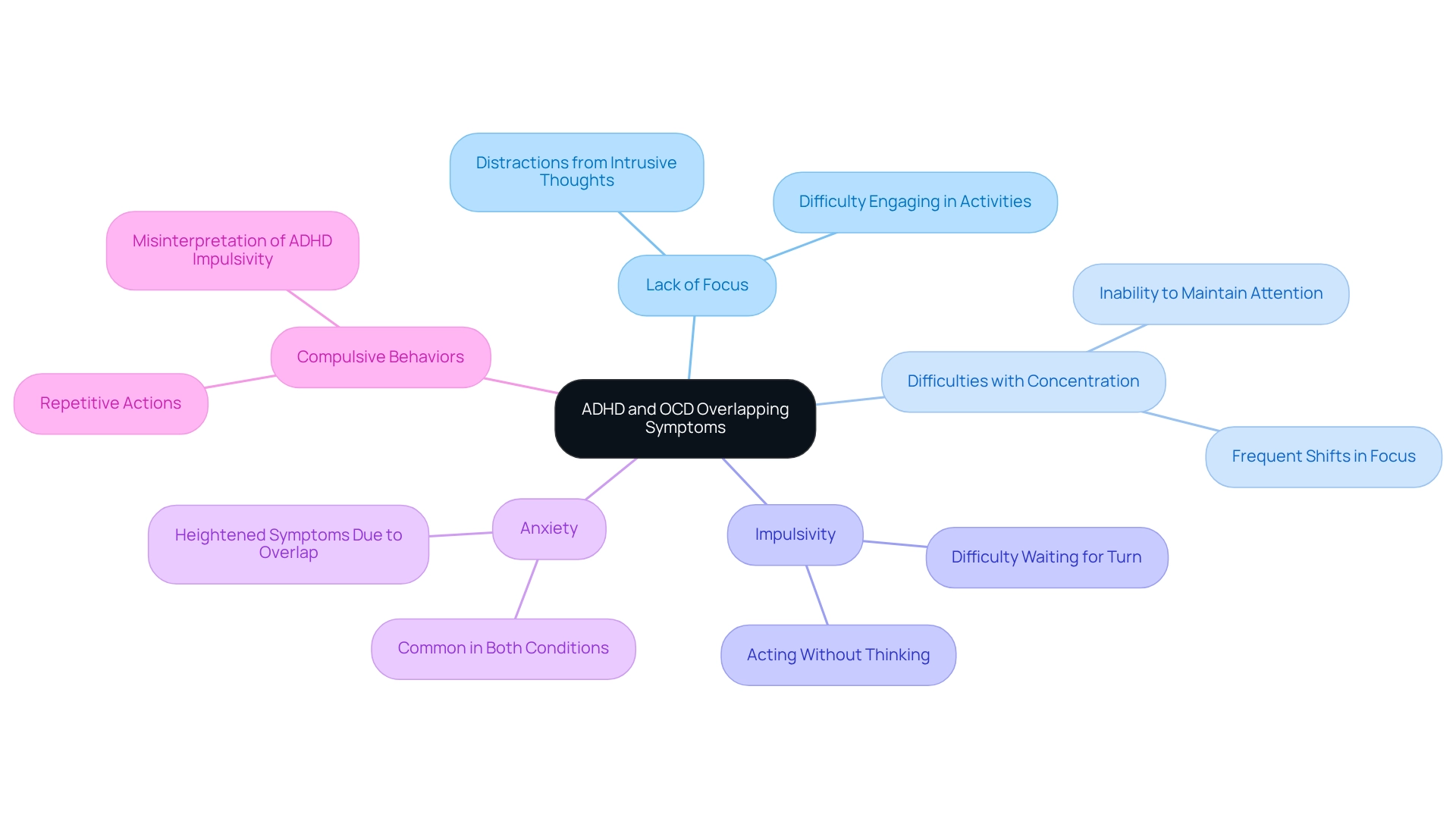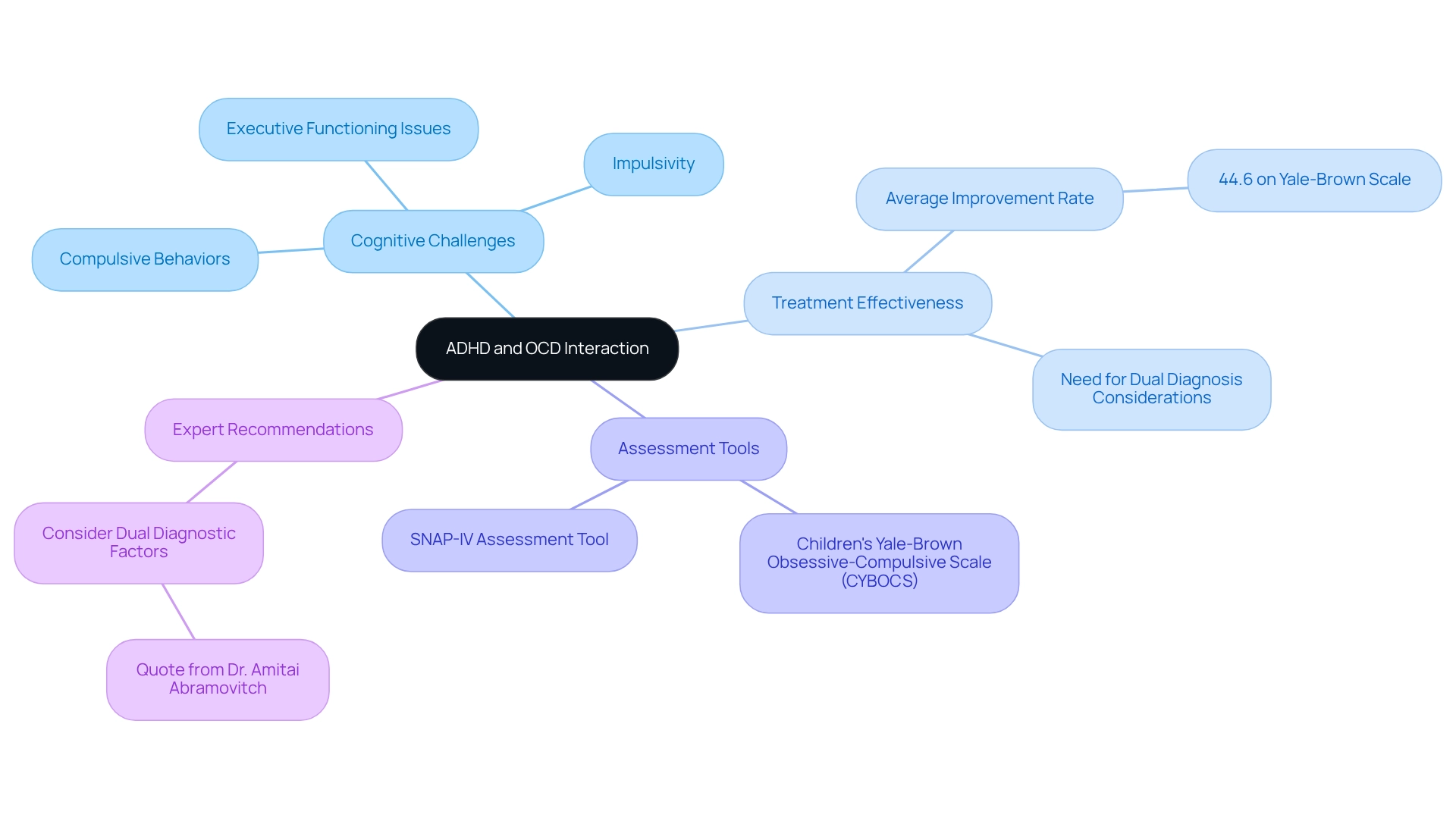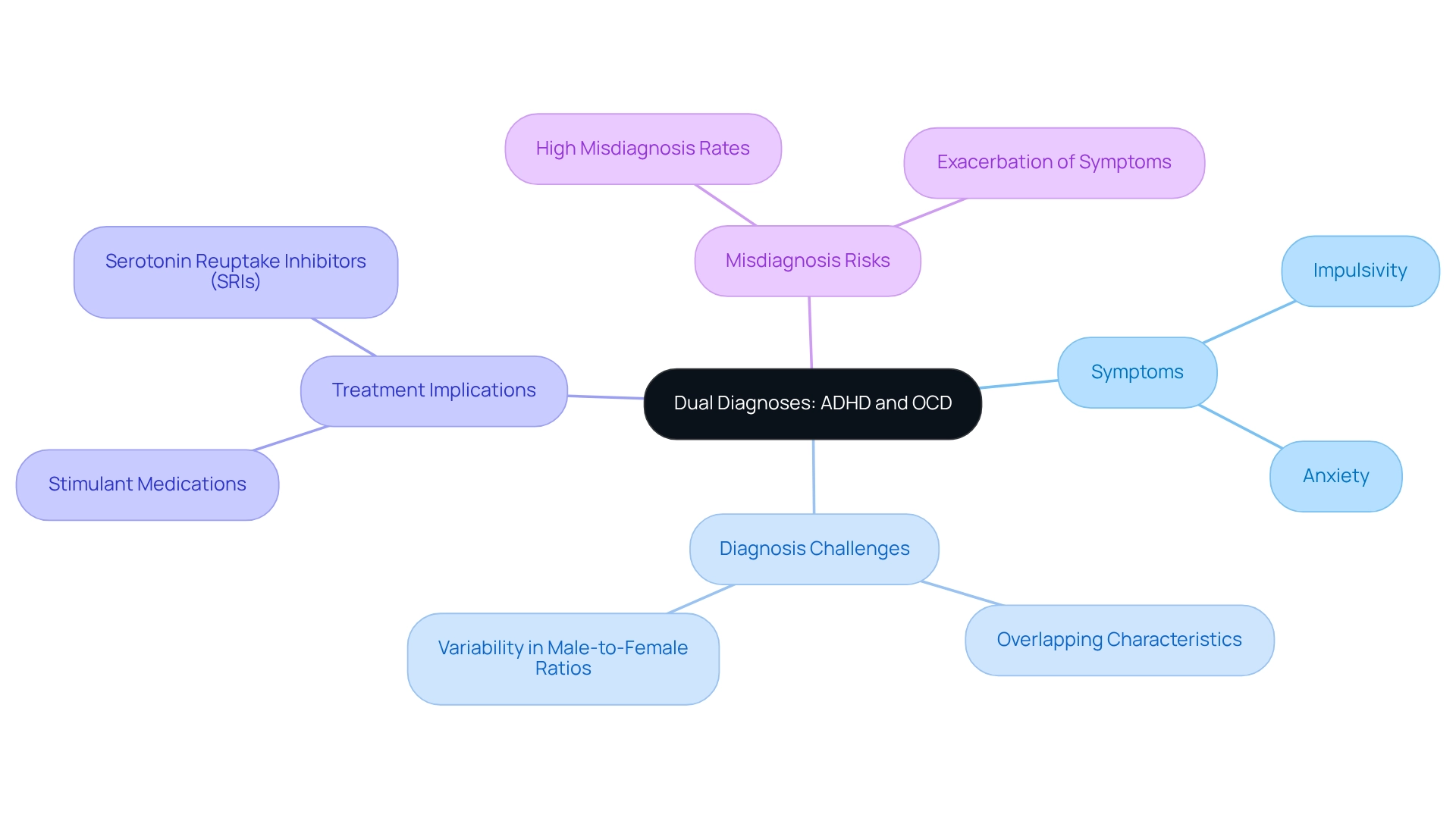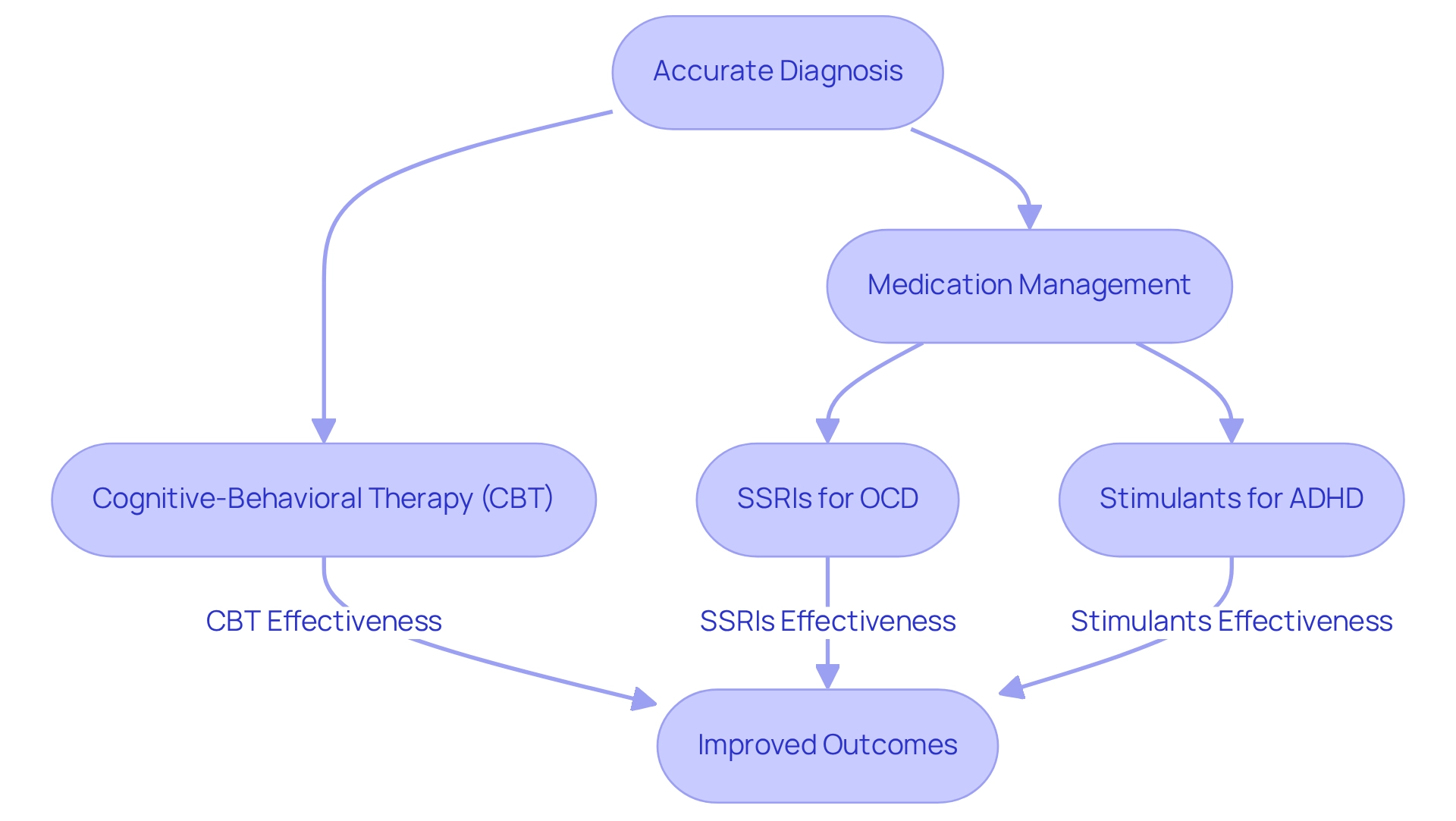Overview
This article sheds light on the journey of identifying and managing ADHD symptoms that may suggest OCD. By exploring the overlapping characteristics and complexities of both disorders, it aims to provide a deeper understanding for those affected. Recognizing the importance of an accurate diagnosis and tailored treatment approaches is crucial, as ADHD symptoms can often mimic OCD behaviors. This reality highlights the need for a nuanced understanding and proactive management strategies that truly support individuals facing these challenges. Together, we can navigate this path with compassion and care.
Introduction
In the intricate landscape of mental health, Attention-Deficit/Hyperactivity Disorder (ADHD) and Obsessive-Compulsive Disorder (OCD) often intertwine, presenting unique challenges for diagnosis and treatment. For many families, navigating these complexities can feel overwhelming. ADHD is characterized by persistent inattention and impulsivity, while OCD is marked by intrusive thoughts and compulsive behaviors. The overlapping symptoms can create confusion for both clinicians and families, making it essential to seek clarity and support.
Recent studies reveal a growing prevalence of these disorders, underscoring the critical need for a nuanced understanding of their co-occurrence. As mental health professionals strive to differentiate between the two, recognizing the subtle manifestations—especially in varying genders—becomes paramount. This understanding is vital for parents and caregivers who are eager to support their loved ones effectively.
This article delves into the complexities of ADHD and OCD, exploring their shared features and the challenges of dual diagnoses. We aim to provide effective strategies for management, empowering families and caregivers in their journey toward better mental health. Together, we can navigate this path with compassion and understanding, fostering hope and resilience in the face of these challenges.
Understanding ADHD and OCD: Definitions and Key Characteristics
Attention-Deficit/Hyperactivity Disorder (ADHD) is characterized by enduring patterns of inattention, hyperactivity, and impulsivity that can significantly hinder functioning and development. For many parents, recognizing the signs can be challenging. Key indicators include:
- Difficulties in maintaining focus
- Frequent restlessness
- Hasty decision-making
These behaviors can manifest across various settings, affecting not only academic performance but also social interactions, which can be distressing for both children and their families.
On the other hand, Obsessive-Compulsive Disorder (OCD) presents itself through unwanted and intrusive thoughts, known as obsessions, which compel individuals to engage in repetitive behaviors or mental acts, referred to as compulsions. Common compulsive behaviors, such as excessive cleaning, checking, or organizing, often aim to alleviate the anxiety stemming from these obsessions. Understanding these behaviors can be crucial for parents seeking to support their children.
It is essential to acknowledge the unique yet interconnected characteristics of ADHD and OCD. Many individuals may encounter signs of both disorders, which can complicate diagnosis and treatment. Recent studies suggest that the presence of ADHD symptoms can influence the manifestation of OCD, necessitating a nuanced understanding of how these conditions interact. For instance, while signs of ADHD, like hyperactivity, are often more apparent, indications of OCD may be subtler and less recognized, particularly in girls who might display internalized behaviors instead of externalized ones.
A case study titled "Gender Differences in ADHD Symptoms" highlights that boys are diagnosed with ADHD more frequently than girls, likely due to the more noticeable externalized symptoms displayed by boys. This disparity can leave many girls undiagnosed and struggling in silence.
Current statistics reveal that ADHD affects approximately 6% of adults, with an estimated 15.5 million adults currently diagnosed with the condition, as reported by Brooke S. Staley. Additionally, many children receive care from primary care professionals, primarily pediatricians. This underscores the importance of awareness and education among healthcare providers to ensure accurate diagnosis and effective treatment approaches for both ADHD and OCD. The 2022 National Survey of Children’s Health also reported an interview completion rate of 78.5%, emphasizing the necessity for thorough evaluations in understanding ADHD prevalence. Community support and cooperation are vital in managing these conditions, fostering a network of understanding and care for affected families.
Common Symptoms: Overlapping Features of ADHD and OCD
Understanding the challenges of OCD and ADHD can be overwhelming for many parents. Both conditions often share similar symptoms, such as lack of focus and difficulties with concentration. For example, a child with attention deficit hyperactivity disorder (ADHD) may struggle to stay engaged in activities, while a child with obsessive-compulsive disorder (OCD) might become preoccupied with intrusive thoughts, leading to distractions. This overlap can create a complex situation where anxiety is common, further intensifying the symptoms of both conditions.
Recent studies emphasize the importance of early identification and intervention, revealing that compromised decision-making linked to OCD can manifest as early as childhood. This highlights the need for parents to be vigilant and proactive in seeking help.
In 2022, the CDC reported a concerning increase in ADHD diagnoses, with an additional 1 million U.S. children aged 3-17 diagnosed compared to 2016. This statistic not only underscores the growing prevalence of these disorders but also emphasizes the significance of understanding their co-occurrence. The 2022 National Survey of Children’s Health, which included 45,483 completed interviews, provided valuable insights into the symptoms of ADHD and OCD, reinforcing the necessity for comprehensive treatment approaches.
Statistical analyses conducted with IBM SPSS Statistics confirmed these findings, establishing a p-value of ≤ 0.05, indicating a strong relationship between the characteristics of both disorders. Mental health professionals stress the importance of recognizing the similarities between ADHD and OCD symptoms. Common indicators such as impulsivity, anxiety, and compulsive behaviors can complicate diagnosis and treatment. For instance, children with ADHD may exhibit impulsive behaviors that could be mistaken for the compulsions often seen in OCD.
Moreover, many children diagnosed with ADHD also experience anxiety disorders, necessitating a thorough approach to treatment that addresses the unique challenges posed by their simultaneous presence. Case studies reveal that numerous children receiving ADHD management from primary care providers often display signs suggestive of OCD but may not receive the specialized support they need. This situation underscores the vital role parents and caregivers play in advocating for appropriate assessments and interventions.
By recognizing the shared characteristics of ADHD and OCD, families can navigate the complexities of these conditions more effectively and pursue strategies for effective management. If you find yourself in this situation, consider reaching out to mental health professionals or support groups to explore resources that can help you and your child.

Identifying ADHD Symptoms That May Mimic OCD
ADHD symptoms and OCD can often be misunderstood, especially when behaviors like excessive organization or repetitive actions come into play. For example, a child displaying ADHD symptoms may frequently check their homework to ensure it is complete. This behavior could easily be mistaken for a compulsion related to obsessive-compulsive disorder. Moreover, impulsivity, a hallmark of ADHD, may manifest in ways that appear ritualistic, such as the need to touch objects in a specific order.
Understanding these differences is crucial for accurate diagnosis and effective treatment.
Research indicates that both ADHD and OCD share deficits within the cortico-striato-thalamic circuits of the brain. While ADHD is linked to impulsive behaviors, OCD is characterized by compulsive actions. A study focusing on the neurodevelopmental aspects of these disorders highlights that early-onset OCD may display distinct neurodevelopmental traits compared to ADHD. This distinction underscores the importance of onset timing in differentiating between these two conditions. The study emphasizes that recognizing the timing and characteristics of onset is vital for understanding the comorbidity of these disorders.
Statistics reveal that the average improvement rate on the Yale-Brown Obsessive Compulsive Scale, after six months of standardized treatment for ADHD symptoms in youth diagnosed with ADHD, was 44.6%. This statistic underscores the necessity of accurately identifying ADHD symptoms to avoid unnecessary therapies that could exacerbate their challenges. Clinicians, including Edna Grunblatt, stress the importance of recognizing behaviors associated with ADHD, particularly ADHD symptoms, as this awareness can profoundly influence treatment strategies and outcomes.
Accurate diagnosis is essential to ensure that young individuals receive the appropriate interventions tailored to their unique needs. If you suspect that your child may be experiencing these symptoms, consider seeking support from a qualified professional who can guide you through this journey.
The Interaction Between ADHD and OCD: Cognitive and Behavioral Insights
Navigating the complexities of attention deficit hyperactivity disorder (ADHD) and obsessive-compulsive disorder (OCD) can be overwhelming for both children and their families. The cognitive processes associated with ADHD, particularly challenges in executive functioning, can exacerbate OCD symptoms. For instance, a young person with ADHD may find it difficult to organize their thoughts, leading to heightened anxiety and the emergence of compulsive behaviors typical of OCD. This relationship is intricate; compulsive behaviors can also distract from the impulsivity often seen in ADHD, creating a challenging cycle that complicates treatment.
Research reveals that children with ADHD show an average improvement rate of approximately 44.6% on the Yale-Brown Obsessive Compulsive Scale after six months of treatment. This statistic underscores the importance of recognizing and addressing the co-occurrence of these disorders, especially given the high rates of comorbidity between ADHD and OCD. Furthermore, studies indicate that the interplay between ADHD and OCD can lead to unique cognitive challenges, such as difficulties with focus and impulse control, which may further aggravate OCD behaviors.
A recent study utilized the Children's Yale-Brown Obsessive-Compulsive Scale (CYBOCS) alongside the SNAP-IV assessment tool to evaluate treatment effectiveness for youth exhibiting signs of both disorders. The findings highlight the necessity of employing validated assessment tools to gain a comprehensive understanding of how ADHD influences OCD symptoms and vice versa.
Experts emphasize the need for clinicians to consider these dual diagnostic factors when assessing youth for OCD and related conditions. As Dr. Amitai Abramovitch, a neuropsychologist and Research Fellow, advises, "We recommend that clinicians examine two major diagnostic factors that may aid in establishing a more accurate diagnosis." Understanding these interactions is vital for developing effective management strategies that address the unique challenges faced by children grappling with both attention difficulties and OCD.
Moreover, the comorbidity of ADHD with OCD may diminish neuropsychological impairments, further complicating treatment options. By fostering a deeper understanding of these interconnected disorders, we can better support families in their journey toward effective management and healing.

Navigating Dual Diagnoses: Challenges in Identifying ADHD and OCD
Recognizing the symptoms of ADHD and OCD simultaneously can be quite challenging due to their overlapping characteristics and the risk of misdiagnosis. It’s not uncommon for clinicians to focus on one disorder, potentially missing the other, which may lead to incomplete treatment strategies. For instance, a child displaying impulsive behavior might be diagnosed solely with attention deficit hyperactivity disorder, leaving underlying OCD traits unaddressed.
Research shows that the average age of onset for OCD is 19.5 years, while attention deficit hyperactivity disorder is a congenital condition that persists throughout life. This complexity complicates the diagnostic landscape, making it crucial for caregivers to be aware of these nuances.
The variability in male-to-female ratios within research samples can further obscure our understanding of how ADHD and OCD coexist. This variability can distort perceptions of prevalence and expression of these conditions, complicating the diagnostic process. Alarmingly, recent studies indicate that misdiagnosis rates are disturbingly high, with stimulant treatments potentially exacerbating symptoms of both ADHD and OCD.
Dee Rapposelli emphasizes that misdiagnosing ADHD in a child with OCD can be particularly problematic, as stimulant treatments may significantly worsen OCD symptoms. Therefore, thorough evaluations—incorporating behavioral assessments and in-depth interviews—are essential for accurate diagnosis and effective treatment planning.
A systematic review by Amitai Abramovitch and colleagues sheds light on the complexities of ADHD and OCD comorbidity throughout the lifespan, underscoring the importance of vigilance among clinicians. A case study on pharmacological interventions for these disorders illustrates this complexity, showing that while stimulant medications may alleviate ADHD symptoms, they can also intensify OCD manifestations. This highlights the need for careful consideration in treatment approaches.
Experts stress the significance of recognizing the dual diagnosis of ADHD and OCD to prevent misdiagnosis. Healthcare professionals must consider the full range of symptoms to ensure that both conditions are appropriately managed. This comprehensive approach ultimately leads to more effective management strategies for affected youth. If you find yourself navigating these challenges, know that support and resources are available to help you through this journey.

Management Strategies: Addressing ADHD Symptoms with OCD Indicators
Managing ADHD symptoms and OCD can feel overwhelming, but effective strategies can make a significant difference. Establishing structured routines, utilizing visual schedules, and implementing targeted behavioral interventions are essential steps. Research shows that organized routines can greatly enhance daily functioning for children facing both conditions. They help lower anxiety and improve focus, creating a predictable environment that nurtures a sense of safety—something vital for young individuals navigating these challenges.
The primary aim of occupational therapy interventions is to enhance 'occupational performance' across various life contexts. This underscores the importance of those structured routines in providing the support children need.
Incorporating mindfulness techniques, such as deep breathing exercises, can further aid in managing anxiety and impulsivity. These practices promote self-regulation and emotional control, which are crucial for young people dealing with the dual challenges of ADHD and OCD. Many children who engage in structured routines report improved emotional well-being and academic performance.
As one participant shared, "It’s, you know, one hour [left] and that’s it; like, I don’t have time to put it off [anymore], and the concentration that I get [from waiting to start] and the sort of effective work style that I get near an eminent deadline [is helpful]."
Additionally, leveraging technology-based interventions, like online self-directed behavioral parent training, shows promise in improving access to effective treatment options. Programs such as EndeavorRX, CogMed, and Cenextra aim to enhance cognitive abilities related to ADHD through engaging gaming elements and adaptive difficulty. While some digital therapies appear promising in reducing ADHD symptoms, the evidence remains inconsistent, highlighting the need for careful evaluation of each program.
Experts emphasize that a diverse approach, integrating structured routines with behavioral techniques, is vital for effectively addressing the challenges of OCD and ADHD. This holistic strategy ultimately leads to better outcomes for children and their families. If you’re seeking support or resources, don’t hesitate to reach out and share your experiences—together, we can navigate this journey.
Tailored Treatment Approaches for Co-Occurring ADHD and OCD
Tailored treatment approaches for individuals exhibiting ADHD symptoms and OCD typically involve a strategic combination of cognitive-behavioral therapy (CBT) and medication management. CBT is particularly effective in addressing the cognitive distortions that are prevalent in both disorders, helping individuals develop healthier thought patterns and coping mechanisms. Recent findings indicate that CBT can significantly improve outcomes for those with these comorbid conditions, with studies showing that approximately 60-70% of patients experience a reduction in symptoms when engaged in structured CBT programs.
In terms of medication management, selective serotonin reuptake inhibitors (SSRIs) are commonly prescribed for OCD, while stimulants such as methylphenidate are utilized to treat ADHD symptoms. Notably, the ratio of males to females in attention deficit hyperactivity disorder is at least 2:1, with some estimates reaching as high as 9:1, which may influence the prevalence of this condition in obsessive-compulsive disorder samples. A significant case study highlights the successful treatment of an adult patient diagnosed with both ADHD symptoms and OCD, who had previously been misdiagnosed with schizophrenia and personality disorder.
After obtaining an accurate diagnosis, the patient was administered extended-release methylphenidate together with antidepressants for OCD, leading to a notable reduction in OCD issues and enhanced overall functioning. This case underscores the importance of reassessing comorbid conditions, such as ADHD symptoms and OCD, and suggests that concurrent treatment can lead to better symptom management. Mental health professionals emphasize that a collaborative approach, involving both therapy and medication, can enhance the quality of life for individuals facing these challenges.
As Geller and colleagues observed, in children, attention deficit hyperactivity disorder that is comorbid with OCD represents a distinct familial subtype. As research continues to evolve, it is clear that understanding the interplay between attention deficit hyperactivity disorder and OCD is vital for developing effective treatment strategies that cater to the unique needs of each individual.

Building Support Systems: Resources for Parents and Caregivers
Creating a strong support network is essential for parents and caregivers navigating the challenges of ADHD symptoms and OCD. Local support groups, online forums, and educational workshops serve as invaluable resources, offering both practical information and emotional backing. Organizations such as CHADD (Children and Adults with Attention-Deficit/Hyperactivity Disorder) and the International OCD Foundation provide tailored resources specifically for families facing these challenges.
Engaging with these communities not only allows caregivers to share their experiences but also fosters a sense of belonging, significantly reducing feelings of isolation. Have you ever felt alone in your journey? You're not alone.
Statistics indicate that a small portion of parents report their offspring receiving effective professional support, highlighting the need for alternative avenues of assistance. In fact, parents rated the helpfulness of the support they received on a scale from 0 (not at all helpful) to 4 (extremely helpful), showcasing the varying degrees of effectiveness in available resources. Peer support and empathy are vital components for caregivers, enhancing their capacity to manage the challenges of raising children with ADHD symptoms and OCD.
For example, a recent study suggested that parents who actively engaged in local support groups felt more empowered and knowledgeable about managing their offspring's symptoms. One parent shared, "At times, I’ve felt like I’ve been, had my wrists slapped for accommodating things, which hasn’t felt very nice," reflecting the emotional challenges faced by caregivers.
Moreover, case studies have shown that early-life family environments significantly influence the risk of developing OCD. The study titled "Early-Life Family Environment and OCD Risk" indicates that factors such as birth order and parental socio-economic status are linked to OCD risk, emphasizing the importance of understanding familial dynamics in treatment approaches. By utilizing community resources and building relationships with other parents, caregivers can tap into a wealth of knowledge and strategies that enhance their ability to assist their children effectively.
This collaborative approach not only improves outcomes for children but also strengthens the resilience of families as they navigate these challenges together. So, consider reaching out, sharing your story, and connecting with those who understand your journey.
Conclusion
Navigating the complexities of ADHD and OCD can be overwhelming, but understanding their overlapping characteristics is crucial. Each disorder presents unique symptoms that complicate diagnosis and treatment: ADHD often leads to impulsivity and inattention, while OCD is characterized by intrusive thoughts and compulsive behaviors. As these conditions become increasingly prevalent, it is vital for healthcare providers and families to be aware of them, highlighting the importance of accurate diagnosis to create tailored management strategies.
Managing ADHD and OCD effectively requires a multifaceted approach. Cognitive-behavioral therapy (CBT), structured routines, and medication management can make a significant difference. Research shows that CBT can greatly improve outcomes for individuals with these comorbid conditions, while structured routines enhance daily functioning and provide stability. Additionally, tapping into community resources and support systems is essential for parents and caregivers. These networks not only offer valuable information but also emotional support, alleviating feelings of isolation.
Ultimately, fostering a collaborative environment that includes mental health professionals, families, and support networks is key to addressing the unique challenges of ADHD and OCD. By prioritizing education and awareness, families can empower themselves and their loved ones on the journey toward improved mental health. Recognizing and managing both conditions effectively is crucial. This holistic approach not only enhances individual well-being but also strengthens family resilience in the face of these complex disorders.
Frequently Asked Questions
What is Attention-Deficit/Hyperactivity Disorder (ADHD)?
ADHD is characterized by enduring patterns of inattention, hyperactivity, and impulsivity that can significantly hinder functioning and development.
What are the key signs of ADHD in children?
Key indicators of ADHD include difficulties in maintaining focus, frequent restlessness, and hasty decision-making.
How does ADHD affect a child's life?
ADHD can affect academic performance and social interactions, causing distress for both children and their families.
What is Obsessive-Compulsive Disorder (OCD)?
OCD is characterized by unwanted and intrusive thoughts (obsessions) that compel individuals to engage in repetitive behaviors or mental acts (compulsions).
What are common compulsive behaviors associated with OCD?
Common compulsive behaviors include excessive cleaning, checking, or organizing, which aim to alleviate anxiety stemming from obsessions.
How are ADHD and OCD interconnected?
ADHD and OCD share unique yet interconnected characteristics, and many individuals may exhibit signs of both disorders, complicating diagnosis and treatment.
What recent findings suggest about the relationship between ADHD and OCD?
Recent studies indicate that ADHD symptoms can influence how OCD manifests, requiring a nuanced understanding of their interaction, especially as signs of ADHD may be more apparent than those of OCD.
Are there gender differences in ADHD diagnosis?
Yes, boys are diagnosed with ADHD more frequently than girls, likely due to the more noticeable externalized symptoms displayed by boys, which can leave many girls undiagnosed.
What are the current statistics on ADHD?
Approximately 6% of adults are affected by ADHD, with an estimated 15.5 million adults currently diagnosed with the condition.
Why is awareness among healthcare providers important for ADHD and OCD?
Awareness and education among healthcare providers are crucial for ensuring accurate diagnosis and effective treatment approaches for both ADHD and OCD.
What does the 2022 National Survey of Children’s Health indicate about ADHD?
The survey reported an interview completion rate of 78.5%, emphasizing the necessity for thorough evaluations in understanding ADHD prevalence.
How can parents support children with ADHD and OCD?
Parents can support their children by recognizing shared symptoms, advocating for appropriate assessments, and seeking help from mental health professionals or support groups.




